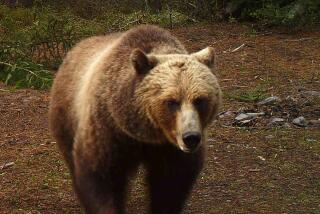Elk Deaths in Wyoming Blamed on Native Plant
- Share via
CHEYENNE, Wyo. — A lichen native to the Rockies is to blame for the deaths this winter of at least 300 elk in southern Wyoming, a die-off that had baffled wildlife scientists and cost the state thousands of dollars, officials said Monday.
Wildlife veterinarians suspected the lichen after finding it in the stomachs of many of the 304 elk that died in south-central Wyoming. Then researchers found reports from 50 years ago that the lichen killed grazing cattle and sheep. Veterinarians at the time believed the ground-dwelling Parmelia molliuscula produced an acid that broke down the livestock’s muscle protein, eventually killing them.
To confirm the suspicions, three elk were fed the lichen at a research facility. One collapsed and was unable to rise Sunday, the Wyoming Game and Fish Department said. A second elk started stumbling, and a third was expected to succumb quickly, officials said. All three will be euthanized.
Game and Fish officials said the lichen is thriving in Wyoming’s drought. As elk and cattle devoured nontoxic forage, the lichen expanded into the open ground.
Elk native to the area weren’t affected by the acid, but those killed in the die-off apparently had moved in from Colorado and may have lacked microorganisms needed to neutralize the acid, state biologists said. The Colorado line is 50 miles south of where the elk died.
“Elk are incredibly adaptable, tough animals,” Game and Fish spokesman Tom Reed said. “They’ll get by on thin rations, and they’ll make do somehow. But this year, nearly 300 of them paid the price for that adaptability.”
The first sick elk was found Feb. 6, and scientists quickly ruled out chronic wasting disease, the deer and elk version of mad cow disease. They also eliminated most viruses and bacteria, malnutrition, exposure to heavy metals such as arsenic, and poisoning from a leaky gas well or pipeline. Officials also were puzzled because nearly 90% of the dead elk were female.
The die-off killed up to 5% of the Sierra Madre herd’s breeding females, and that will affect hunting quotas this fall and could trigger wildlife policy changes, Reed said.
Other steps, such as improving range conditions to provide healthier forage, will be considered as researchers try to prevent future die-offs.
More to Read
Sign up for Essential California
The most important California stories and recommendations in your inbox every morning.
You may occasionally receive promotional content from the Los Angeles Times.













